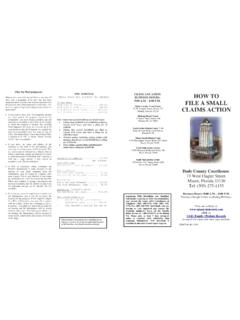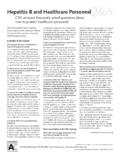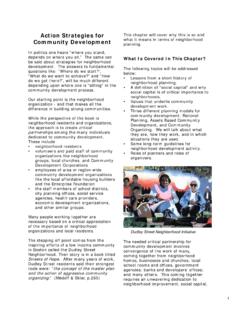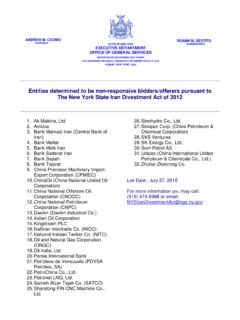Transcription of Hurricane Sandy After Action - nyc.gov
1 Hurricane Sandy After Action Report and Recommendations to Mayor Michael R. Bloomberg May 2013. Deputy Mayor Linda I. Gibbs, Co-Chair Deputy Mayor Caswell F. Holloway, Co-Chair Cover photo: DSNY truck clearing debris Credit: Michael Anton Foreword On October 29, 2012 Hurricane Sandy hit New York City with a ferocity unequalled by any coastal storm in modern memory. Forty-three New Yorkers lost their lives and tens of thousands were injured, temporarily dislocated, or entirely displaced by the storm's impact. Knowing the storm was coming, the City activated its Coastal Storm Plan and Mayor Bloomberg ordered the mandatory evacuation of low-lying coastal areas in the five boroughs.
2 Although the storm's reach exceeded the evacuated zones, it is clear that the Coastal Storm Plan saved lives and mitigated what could have been significantly greater injuries and damage to the public. The City's response to Hurricane Sandy began well before the storm and continues today, but we are far enough away from the immediate events of October and November 2012 to evaluate the City's performance to understand what went well and as another Hurricane season approaches what can be improved. On December 9, 2012 Mayor Bloomberg directed us to conduct that evaluation and report back in a short time with recommendations on how the City's response capacity and performance can be strengthened in the future.
3 This report and the 59 recommendations in it are intended to advance the achievement of those goals. This report is not intended to be the final word on the City's response to Hurricane Sandy , nor are the recommendations made here intended to exclude consideration of additional measures the City and other stakeholders could take to be prepared for the next emergency. But these recommendations are based on several months of intensive and comprehensive effort by City agencies, and include input from many stakeholders, including nonprofit partners, New York State agencies, and an extensive set of hearings held by the New York City Council.
4 We hope you find this report useful, and we look forward to working within the City and with many other public and private stakeholders to implement these recommendations and any other measures that strengthen the City's ability to meet the needs of New Yorkers when the unexpected happens. On a final note, we would like to thank the thousands of City workers and volunteers who worked tirelessly for days, weeks, and months to help New Yorkers and our City recover After the storm. Together, we will ensure that the City is even better prepared to meet New Yorkers' needs going forward. Linda Gibbs, Deputy Mayor for Health and Human Services Cas Holloway, Deputy Mayor for Operations NYC Hurricane Sandy After Action Report - May 2013 1.
5 Table of Contents FOREWORD 1. INTRODUCTION AND EXECUTIVE SUMMARY 4. COMMUNICATIONS 6. GENERAL AND HEALTHCARE FACILITY EVACUATIONS 8. General Evacuation 9. Healthcare Facility Evacuations 11. PUBLIC SAFETY 12. 911 and Emergency Response 12. Public Safety Operations and Equipment 12. Power Outages, Generators, and Boilers 14. SHELTERING 16. Shelter Logistics and Operations 16. Special Medical Needs Shelters 17. RESPONSE AND RECOVERY LOGISTICS, UTILITIES, AND INFRASTRUCTURE 18. Residential and Commercial Building Re-occupancy and Public Infrastructure Restoration 19. Fuel and Transportation 21. Debris Removal 22.
6 Telecommunications 24. COMMUNITY RECOVERY SERVICES 25. Food, Water, and Goods Distribution 26. Vulnerable Populations and Special Needs 27. Access to Healthcare 27. Restoration Centers 28. NYC Service Coordination of Volunteers and Donations 29. Business Recovery 30. ONGOING RECOVERY 32. Housing: Hotel Program and NYC Rapid Repairs 32. Nonprofit Recovery 32. Collaboration with Mayor's Fund to Advance New York City 33. Community Development Block Grant-Disaster Recovery Programs 34. CONCLUSION 36. APPENDICES AND RESOURCES 37. Appendix A: List of New York City agencies and acronyms Appendix B: Post- Sandy Survey of Zone A Residents Appendix C: Sample Utility Outage Report Appendix D: Sample Fuel Report Appendix E: Sample DOB Structural Assessment Report Appendix F: Sample Daily NYC Rapid Repairs Reports 2 NYC Hurricane Sandy After Action Report - May 2013.
7 Photo: NYC Department of Transportation / Stephen Mallon NYC Hurricane Sandy After Action Report - May 2013 3. Introduction and Executive Summary This After Action report is a high-level summary of recommend- Hurricane Sandy hit New York City on Monday, October 29, 2012. ed improvements to the City's operations before, during, and Starting several days before the storm, Mayor Bloomberg con- immediately following Hurricane Sandy and was developed by vened daily executive-level briefings at City Hall and OEM Head- the Mayor's Office with input from the many City agencies that quarters in Brooklyn to receive detailed briefings from agency responded and continue to participate in the City's recovery commissioners and senior staff; the National Weather Service from the storm.
8 This report is not an exhaustive list of all les- (NWS); agency partners including the Metropolitan Transpor- sons learned; it includes some, but not all, of the many internal tation Authority (MTA) and the New York State Department of operational adjustments that City agencies will make and in Health (NYS DOH); and others. These briefings, along with wors- many cases have already made to staffing, communications, ening weather forecasts, led OEM to activate the Emergency Op- and deployment of resources. Rather, it is a roadmap of the stra- erations Center (EOC) on Friday, October 26, which became the tegic steps the City will take to improve our ability to protect life nerve center for storm response management.
9 The Mayor held and property in the face of the increasing risk of severe weather. the first of many daily press conferences to update New Yorkers Organized by crosscutting themes and focused on addressing the same day. Based on the storm's trajectory and strength on the City's most immediate needs before, during, and After a se- that date, OEM also opened the Logistics Center (LC) to provide vere storm, this report establishes the City's priorities for how supplies, equipment, and other resources to responding agen- to prepare for the next severe storm. In many cases, the recom- cies. In accordance with the CSP, OEM activated the Healthcare mendations in this report are applicable beyond coastal storms Evacuation Center (HEC) at OEM to prepare for the possible and will increase the City's overall preparedness to respond to evacuation of healthcare facilities; and the Emergency Sup- catastrophic events.
10 Ply Stockpile was activated to provision the City's emergency shelter system in the event of an evacuation. A key decision . The current iteration of the City's formal preparations for a coast- whether to issue a mandatory evacuation order was made al storm began in 2000 with the release of the Coastal Storm following updated storm surge predictions from the National Plan (CSP), a collection of programs to prepare and respond to Weather Service on the morning of October 28. a storm, including evacuation, sheltering, and logistics plan- ning. A coastal storm presents a known but largely unpredict- Following the storm, the geographic scope and extent of the able threat: known because large coastal storms form far away damage in the hardest hit areas required neighborhood-level from the northeast coast of the United States and can be tracked decision making to ensure that community needs were being for several days before they impact the New York City region.













